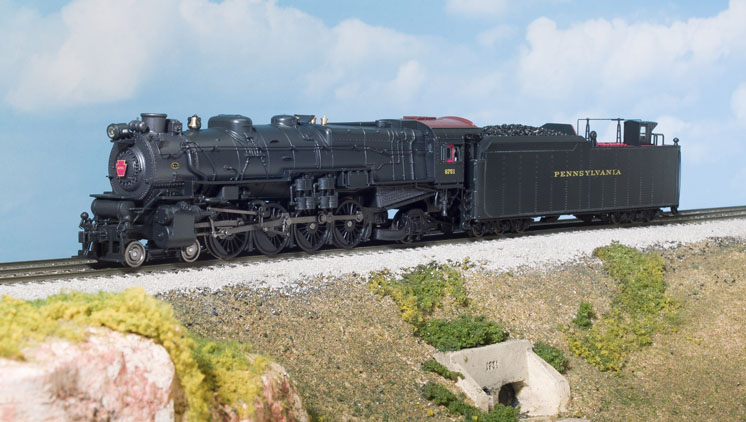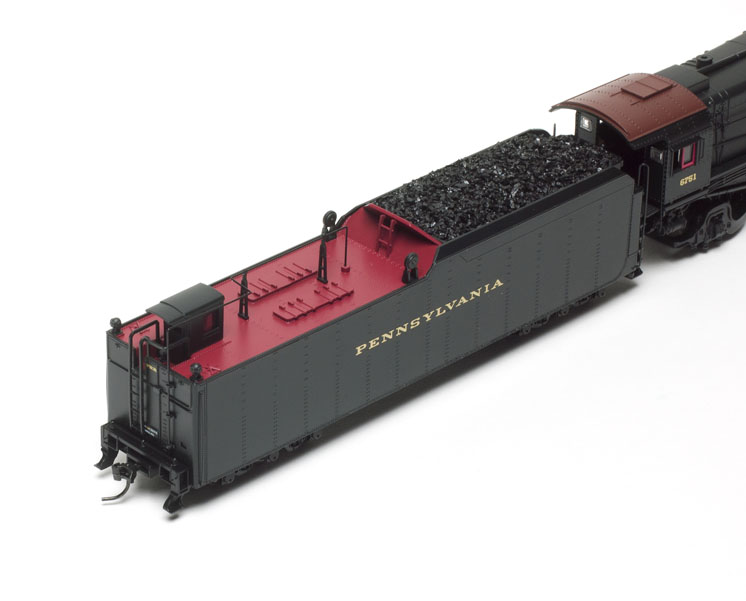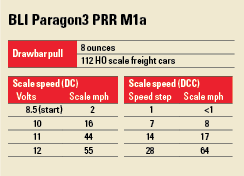The prototype. The Pennsylvania RR rostered 301 4-8-2 “Mountain” type steam locomotives built by Baldwin, Lima, and PRR’s own Juniata Shops. The locomotives included a 1923 prototype (no. 4700, re-numbered 6699), the 1926 M1 class (nos. 6800 to 6999), and the 1930 M1a class (nos. 6700 to 6799). The M1a class featured cylinder saddles without outside steam pipes, dual air pumps, and a Worthington feedwater heater. In the 1940s some M1a locomotives were re-classed M1b after further modifications, including increased steam pressure and firebox circulators.
Although most of the PRR 4-8-2s hauled exclusively freight, they were originally designed as dual-service locomotives. Serving the Pennsy into the 1950s, the M-class steamers all received PRR chime whistles and keystone number plates instead of the “banshee” whistle and round plates found on freight-only locomotives.
The model. Most of the model’s dimensions are within scale inches of prototype drawings in Model Railroader Cyclopedia: Vol. 1, Steam Locomotives (Kalmbach Publishing Co.). On the model the wheelbase of the pilot truck and the distance from the pilot to the first driver axle is several scale inches longer than the prototype. This and a 3 scale foot space between the cab and tender deck help the model negotiate tight 18″ radius curves. A second hole in the drawbar is provided for more prototypical locomotive and tender spacing, but wider curves are required.
The boiler, cab, and tender are made of plastic. Molded details, including boiler bands, sand lines, and tender rivet seams, match prototype photos. Separate detail parts include the bell, whistle, safety valves, handrails, and train-phone equipment on the 210-F-75 tender.
With its footboard rather than slatted pilot and its dynamo mounted behind the headlight, our review sample accurate models an M1a in the late 1930s through World War II.
I appreciated that BLI included painted crew figures inside the cab and an accurately detailed backhead and cab apron.
The model’s paint matches the prototype, including Pennsy’s “almost black” Dark Green Locomotive Enamel. The pennsylvania across the sides of the tender matches the prototype font and spacing. The printing on the builder’s plate and tender class plate is legible.
Performance. A gearbox connects the third axle to the can motor. The metal siderods transfer power to the other axles. Traction tires on the rearmost drivers and a die-cast metal chassis help the M1a achieve an impressive 8 ounces of drawbar pull. The locomotive proved its hill-climbing ability by hauling 40 HO scale freight cars up a 3 percent grade on our layout. A wiring harness connects the DCC decoder and other electronics in the tender to the locomotive.
On our DCC test track the model crept along smoothly at less than 1 scale mph. The top speed of 64 scale mph is close to that of the prototype.
Sound effects. The biggest upgrade to the Paragon3 system is its support of the Rolling Thunder system (See the review on page 85). The Paragon3 locomotive includes all the same user-triggered effects and programmable CVs as the BLI Paragon2 series. Using a DCC system I could adjust the volume of individual sound effects, set up speed tables, and remap function keys. Extensive Paragon3 user and technical manuals are available as a free download at the Broadway Limited website.
The locomotive exhaust chuffs four times per driver revolution, just like the prototype. When activated, the smoke unit puffs in synch with the chuffs. Pressing the whistle button on my NCE throttle sounded a chime whistle.
Along with the whistle, bell, and headlight dynamo, sound effects include the injectors, air pump, and coal auger. In addition to coupler crash sounds, function 3 is used to activate the sound of drawbar slack being let out when the locomotive starts moving. The number of times this effect repeats to simulate a greater number of cars is also adjustable.
I don’t have much use for the various radio dialog effects. However, I’m glad that functions 5 and 6 are present to allow me to adjust the intensity of the exhaust sounds. This is especially useful to simulate the quiet chuffs of a locomotive drifting downgrade or the heavy chuffs of an engine starting out.
The Paragon3 locomotive has four times the storage space for its Autopilot feature. I could program the locomotive to run at a specific speed, make stops, and play sound effects automatically.
DC performance. On our direct-current (DC) test track, the M1a required 8.5 volts before it started moving at 2 scale mph. Fortunately for DC users, BLI includes configuration variables (CVs) to adjust DC performance. To improve the control range, I set the Sound Unit Startup (CV 131) to a value of 1 and the Analog Start Voltage (CV 252) to a value of 70. The sounds then started at 6.5V and the locomotive started moving at just under 7V.
These CVs are easily adjusted with a BLI DC Master Analog control module (sold separately for $49.99), which also lets DC users trigger the whistle and other sound effects.The BLI M1a remains a detailed depiction of PRR’s famed 4-8-2. The upgraded electronics and novel new sound features make it better than ever.
Price: $449.99
Manufacturer
Broadway Limited Imports LLC
9 East Tower Circle
Ormond Beach, FL 32174
www.broadway-limited.com
Era: late 1930s to mid-1940s (as detailed)
Road numbers: M1a (pre-1946): 6751, 6712, and 6788
M1b: 6702, 6733, and 6761
Undecorated versions available.
Features
▪▪Die-cast metal chassis
▪▪Electrical pickup on six drivers and all tender wheels
▪▪Golden-white light-emitting diode headlight
▪▪Metal operating knuckle coupler at correct height on rear of tender (Fixed coupler on pilot)
▪▪Metal wheels in gauge and roll smoothly on codes 70, 83, and 100 rail
▪▪Minimum radius: 18″
▪▪Paragon3 dual-mode sound decoder with dual speakers
▪▪Synchronized smoke unit
▪▪Weight: 1 pound 8 ounces,
▪▪15 ounces (engine alone)

















